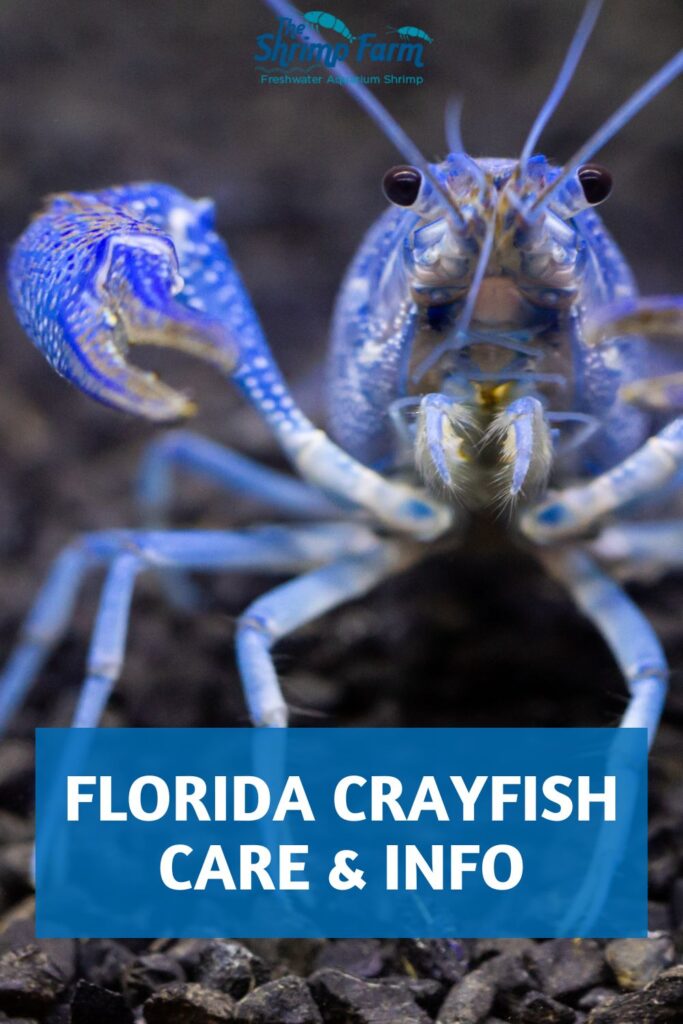Florida Crayfish | Procambarus alleni care & info
Interested in keeping a crayfish in your freshwater aquarium? One of the most popular options is the blue form of the Florida crayfish, also known as the electric blue crayfish. Beautifully colored and quite feisty, these invertebrates are easy to keep but do have some care requirements!
Keep reading for everything you need to know about Florida crayfish care and how to keep Procambarus alleni alive and thriving in your home aquarium.
| Scientific name | Procambarus alleni |
| Common names | Florida crayfish, electric blue crayfish, Everglades crayfish, sapphire crayfish |
| Difficulty level | Easy |
| Origin | Florida |
Table of Contents
Florida crayfish appearance & natural habitat
Appearance
At a maximum length of up to 5", the Florida crayfish is considered a medium-sized crayfish. The wild form of this species is greyish or brownish in color, usually with hints of blue and red on the claws.
It's rare nowadays to stumble upon wild-colored Florida crayfish in your local aquarium store. The selectively bred blue version, known as the electric blue crayfish, has pretty much completely overtaken it! Not surprising, in our opinion, as the blue coloration with its lighter speckling really is quite spectacular.
Natural habitat
As the name suggests, the Florida crayfish is indeed found exclusively in the state of Florida. It's a common sight in the Everglades, as well as pretty much everywhere in the panhandle that's located south of Levy and Marion Counties and east of the St Johns River.
In the wild, this species inhabits a range of different habitat types, from swamps to drainage ditches. It's very adaptable, meaning it can survive pretty much everywhere! Stagnant, warm and dirty waters are generally no problem for the Florida crayfish.
Even if a pond dries up, the crays can simply burrow into the mud or sand to wait out the dry season in relative safety. In fact, they're more common in areas that experience seasonal droughts than some of their Procambarus cousins, like P. fallax.
Procambarus alleni has even been found to be able to withstand brackish water. This comes in quite handy in areas like Florida's many floodplains, which flood with seawater on a regular basis.
The IUCN considers this crayfish to be a species of Least Concern, noting it's quite common in its natural range. It does mention that the dry seasons in its natural habitat are lengthening as a result of climate change. In the long run, they might become too long for the crays to survive in their burrows, ultimately damaging the population. Irresponsible water management may also pose a threat to the species.
Invasive potential
Because they're so adaptable (and breed quite vigorously), crayfish have huge invasive potential. As a result of specimens escaped or released from aquariums, there are already massive feral populations of American species like the marbled crayfish (Procambarus virginalis) and red swamp crayfish (Procambarus clarkii) present around the world, like in Europe.
It seems Procambarus alleni hasn't managed to gain as much of a foothold outside of its natural range as these species, they do have somewhat of a presence in various regions of Europe and beyond. Non-native crayfish can potentially threaten native populations and even entire ecosystems, so please be mindful of this.
Never release a Florida crayfish (or any aquarium fish or invertebrate, for that matter), into the wild!
Setting up a Florida crayfish aquarium
Tankmates
If you'd like to keep a Florida crayfish, the main thing you'll need to keep in mind is that they're not well-suited to community aquariums. These are opportunistic omnivores, which basically means they'll eat anything they can get their claws on. That includes their tankmates, and even their own species! As such, it's usually best to keep them on their own.
You may get away with keeping these crayfish with certain species of fish, but they would need to be quick and nimble in order to avoid being snapped up. Something like a school of zebra Danios may work, but we personally prefer a single-species set-up for Procambarus species here at The Shrimp Farm.
Some aquarists have kept multiple Florida crayfish in the same tank with some success, and if you'd like to breed yours without having multiple aquariums, you'll have to. However, it would be extremely important to go for a large aquarium and provide lots of hides.
The crays should be roughly the same size to prevent the larger ones from viewing the smaller ones as lunch. Introducing all inhabitants to the tank at the same time can help prevent territorial aggression.
Requirements
An aquarium of around 20 gallons should work well for a single Florida crayfish, with at least 10 extra gallons for each additional cray being ideal.
Be sure to include plenty of tubes and caves, as these are nocturnal creatures that like to be able to retreat to a safe spot during the daytime. They also tend to hide around molting time, which occurs every few days for baby crays and around once every two months for adults.
As mentioned in the section on habitat, these crayfish are avid burrowers. In the aquarium, yours will appreciate a nice and thick layer of sandy substrate. Don't bother with plants, unless they're floaters or meant as food: any greenery will be relentlessly mowed down and eaten. Research shows that Florida crayfish do actually prefer densely planted habitats, but it's just a little difficult when they view their tank décor as food!
And by the way, it's not just the plants that will be affected. Crayfish love rearranging their homes and moving stuff around, so if you want a pretty and organized aquascape, they're probably not for you.
Tip: Crayfish are escape artists. To prevent yours from making its way out of its tank and drying up on the floor, be sure to use a tight-fitting aquarium hood and block any holes.
Water quality
As mentioned earlier, Florida crayfish are not too finicky when it comes to water quality. This is one of the reasons they're such a good choice for beginning fishkeepers: the little initial mistakes that might negatively affect other species are unlikely to be much of an issue for a crayfish.
However, all this doesn't mean you shouldn't provide yours with clean water! They'll live longer (up to 5 years) in a well-filtered, cycled aquarium that receives regular water changes. It's also recommended to use a bubbler or give your Florida crayfish the option of climbing out of the water, as apparently they can drown if the water is not sufficiently oxygenated.
pH: 7-9
Temperature: 65-85 °F
Hardness: 3-10
Florida crayfish diet
As we discussed earlier, Florida crayfish are opportunistic omnivores. They'll eat anything! In the aquarium, just be sure to offer a varied diet for optimal health. It's especially important to include calcium-rich foods or calcium supplements, as the crays need these to be able to molt successfully.
You can feed your Florida crayfish a base diet of high-quality invertebrate food, along with a variety of other meals:
- Blanched vegetables
- Frozen fish foods
- Regular sinking fish flakes
- Algae tablets
You can feed your crayfish daily. Be sure to remove any uneaten foods after a few hours to avoid water quality issues.
Breeding Florida crayfish
If you put a fully-grown male and female Florida crayfish in the same aquarium, they're almost guaranteed to end up mating. Some aquarists like to keep pairs in the same aquarium, but since they will still aggressively defend their own territories, it may be preferable to maintain two separate set-ups.
The crayfish mating process is easy to confuse with a fight: the two will lock in an intimate embrace, with the male pinning the female on her back. After this, the couple go their own separate ways. The female will move eggs from her ovaries to her swimmerets (back legs), where she diligently fans and cleans them until they hatch after 20-30 days.
After the babies emerge from their eggs, they will generally stay under mom's tail for a few days before striking out on their own. It's best to raise them in a separate aquarium to prevent them from being eaten by their own parents!
Buying Florida crayfish
The Florida crayfish, especially the electric blue variety, is one of the most common crayfish species in the aquarium hobby. Unlike some other crays, which may be banned in certain countries or states, there are usually no legal restrictions on buying them.
Frequently asked questions
Procambarus alleni lifespan is around five years. With the right care, yours might live even longer than that!



 Shrimp
Shrimp Fish
Fish Crab &
Crab & Plants
Plants Foods
Foods Snails
Snails
